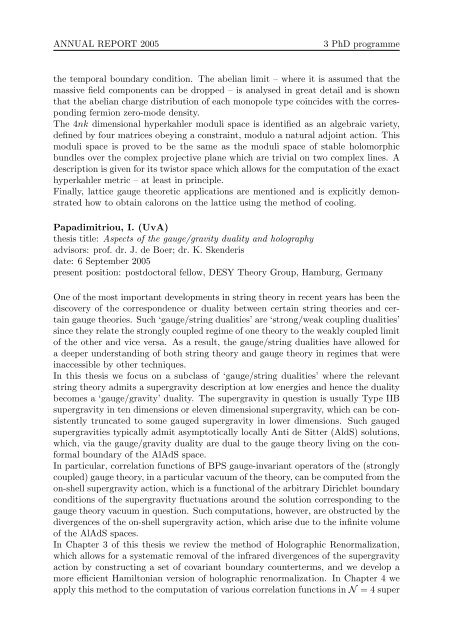ANNUAL REPORT 2005 - Universiteit Utrecht
ANNUAL REPORT 2005 - Universiteit Utrecht
ANNUAL REPORT 2005 - Universiteit Utrecht
You also want an ePaper? Increase the reach of your titles
YUMPU automatically turns print PDFs into web optimized ePapers that Google loves.
<strong>ANNUAL</strong> <strong>REPORT</strong> <strong>2005</strong>3 PhD programmethe temporal boundary condition. The abelian limit – where it is assumed that themassive field components can be dropped – is analysed in great detail and is shownthat the abelian charge distribution of each monopole type coincides with the correspondingfermion zero-mode density.The 4nk dimensional hyperkahler moduli space is identified as an algebraic variety,defined by four matrices obeying a constraint, modulo a natural adjoint action. Thismoduli space is proved to be the same as the moduli space of stable holomorphicbundles over the complex projective plane which are trivial on two complex lines. Adescription is given for its twistor space which allows for the computation of the exacthyperkahler metric – at least in principle.Finally, lattice gauge theoretic applications are mentioned and is explicitly demonstratedhow to obtain calorons on the lattice using the method of cooling.Papadimitriou, I. (UvA)thesis title: Aspects of the gauge/gravity duality and holographyadvisors: prof. dr. J. de Boer; dr. K. Skenderisdate: 6 September <strong>2005</strong>present position: postdoctoral fellow, DESY Theory Group, Hamburg, GermanyOne of the most important developments in string theory in recent years has been thediscovery of the correspondence or duality between certain string theories and certaingauge theories. Such ‘gauge/string dualities’ are ‘strong/weak coupling dualities’since they relate the strongly coupled regime of one theory to the weakly coupled limitof the other and vice versa. As a result, the gauge/string dualities have allowed fora deeper understanding of both string theory and gauge theory in regimes that wereinaccessible by other techniques.In this thesis we focus on a subclass of ‘gauge/string dualities’ where the relevantstring theory admits a supergravity description at low energies and hence the dualitybecomes a ‘gauge/gravity’ duality. The supergravity in question is usually Type IIBsupergravity in ten dimensions or eleven dimensional supergravity, which can be consistentlytruncated to some gauged supergravity in lower dimensions. Such gaugedsupergravities typically admit asymptotically locally Anti de Sitter (AldS) solutions,which, via the gauge/gravity duality are dual to the gauge theory living on the conformalboundary of the AlAdS space.In particular, correlation functions of BPS gauge-invariant operators of the (stronglycoupled) gauge theory, in a particular vacuum of the theory, can be computed from theon-shell supergravity action, which is a functional of the arbitrary Dirichlet boundaryconditions of the supergravity fluctuations around the solution corresponding to thegauge theory vacuum in question. Such computations, however, are obstructed by thedivergences of the on-shell supergravity action, which arise due to the infinite volumeof the AlAdS spaces.In Chapter 3 of this thesis we review the method of Holographic Renormalization,which allows for a systematic removal of the infrared divergences of the supergravityaction by constructing a set of covariant boundary counterterms, and we develop amore efficient Hamiltonian version of holographic renormalization. In Chapter 4 weapply this method to the computation of various correlation functions in N = 4 super
















